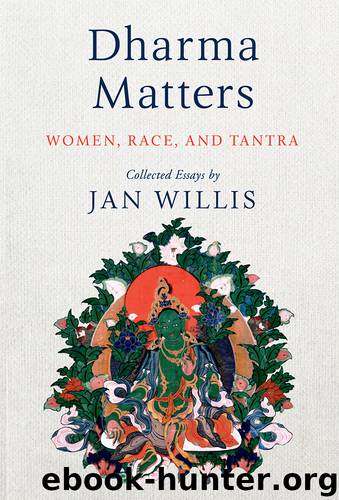Dharma Matters by Jan Willis

Author:Jan Willis
Language: eng
Format: epub
Publisher: Wisdom Publications
CHI, THE HISTORICAL
In his monumental work Tibetan Painted Scrolls, published in 1949, the great Tibetologist Giuseppe Tucci compared namthar with Christian hagiography and suggested that history was never the intended purview of the genre. He wrote:
rNam t’ar much resemble the lives of saints widely circulated during our Middle Ages; they must be considered neither histories nor chronicles. The events they relate with a particular satisfaction are spiritual conquests, visions and ecstasies; they follow the long apprenticeship through which man becomes divine, they give lists of the texts upon which saints trained and disciplined their minds, for each lama they record the masters who opened up his spirit to serene visions, or caused the ambrosia of supreme revelations to rain down upon him. Human events have nothing to do with these works, and how could they, being a vain flow of appearances in the motionless gleam of that void, never to be grasped, into which the experience of truth dissolves and annuls us? . . . All the rest is shadows.323
For all its poetry, it must be admitted that Tucci’s description of namthar does not do much to inform us about the actual nature or function of the genre. To be sure, the siddha’s spiritual biography (the inner and secret levels) takes precedence over the outer biography in such literature. Still, for the six Gelukpa examples translated here, Tucci’s assessment would be quite inappropriate. For in these six, human events do figure in. Names, places, and verifiable dates are mentioned, and human beings are historical as well as religious actors in the central drama that unfolds the path to enlightenment.
To begin, the six siddhas and their respective dates should be considered. They are:
1. Tokden Jampal Gyatso (1356–1428)
2. Baso Chökyi Gyaltsen (1402–1473)
3. Drupchen Chökyi Dorjé (?)
4. Gyalwa Ensapa (1505–1566)
5. Khedrup Sangyé Yeshé (1525–1591)
6. Jetsün Losang Chökyi Gyaltsen (1570–1662)
As can be seen from their dates, these six lives span some three hundred years of Tibetan religious history, particularly that period covering the rise to power of the Yellow Hat,324 or Gelukpa, order. Because the lives are contiguous, through them we are able not only to witness a continuous lineage of Gelukpa Mahamudra practitioners but to view continuously unfolding historical developments, both as they impacted on and were influenced by these six. Through them, one learns who knew whom, what places were frequented, and where certain monasteries were founded and why. Moreover, through this particular set of lives, we can observe directly the intricate interweaving of politics and religion in Tibet during this period.
It is of interest, for example, to learn that four of these six siddhas, who succeeded Tsongkhapa (1357–1419) in the Geluk Mahamudra lineage, were personally connected with the first five Dalai Lamas. Baso Chökyi Gyaltsen became abbot of Ganden (Dga’ ldan) Monastery on the order of the First Dalai Lama, Gendundrub (Gde ’dun grub, 1391–1475). One of Baso’s Mahāmudrā disciples, Palden Dorjé (Dpal ldan rdo rje), studied with and taught the Second Dalai Lama, Gendun Gyatso (Gde ’dun rgya mtsho, 1476–1542). Later, Gyalwa Ensapa was ordained by the Second Dalai Lama and studied under him.
Download
This site does not store any files on its server. We only index and link to content provided by other sites. Please contact the content providers to delete copyright contents if any and email us, we'll remove relevant links or contents immediately.
The Way of Zen by Alan W. Watts(5800)
Ego Is the Enemy by Ryan Holiday(3991)
The Art of Happiness by The Dalai Lama(3385)
The Book of Joy by Dalai Lama(3218)
Why Buddhism is True by Robert Wright(2827)
Shift into Freedom by Loch Kelly(2692)
Spark Joy by Marie Kondo(2677)
Happiness by Matthieu Ricard(2524)
A Monk's Guide to a Clean House and Mind by Shoukei Matsumoto(2405)
The Lost Art of Good Conversation by Sakyong Mipham(2125)
The Meaning of the Library by unknow(2069)
The Third Eye by T. Lobsang Rampa(1883)
The Unfettered Mind: Writings from a Zen Master to a Master Swordsman by Takuan Soho(1859)
Anthology by T J(1754)
Red Shambhala by Andrei Znamenski(1748)
The Diamond Cutter by Geshe Michael Roach(1671)
Thoughts Without A Thinker: Psychotherapy from a Buddhist Perspective by Epstein Mark(1593)
Advice Not Given by Mark Epstein(1522)
Twilight of Idols and Anti-Christ by Friedrich Nietzsche(1491)
